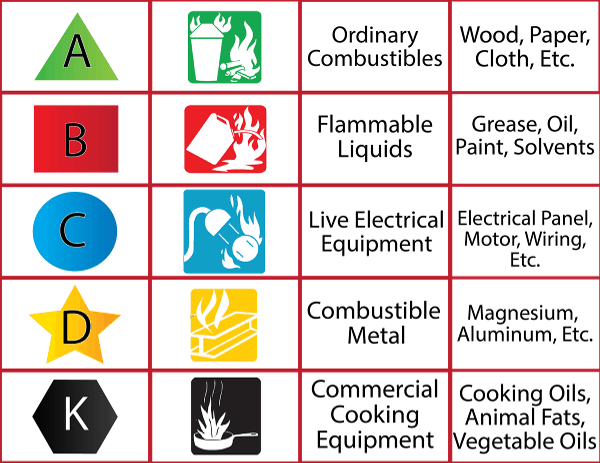Ensure Your Commercial Building Has the Appropriate Fire Extinguishers
Although most commercial building owners are aware that they are required by law to have fire extinguishers, they may not be aware of the various types of extinguishers that are best suited for their specific business operations. Each specific type of fire extinguisher is developed for a certain type of fire and may only be applicable in particular situations. Learn about the different types of extinguishers below to ensure you and your building occupants will be safe in the case of a fire emergency.

Becoming familiar with these five fire classifications is critical to determining the type of extinguishers required for your building.
ABC Dry Chemical
One of the most common types of extinguishers, the ABC Dry Chemical can be used on class A, B and C fires. With a specially designed powder, this extinguisher helps to eliminate fires started by burning gases, liquids, electrical fires and common combustible solids. Generally, this extinguisher is an excellent choice for an office type environment.
Water Mist
Primarily utilized in facilities with sensitive equipment, such as a healthcare facility or hospital, this type of extinguisher can eliminate a fire threat without causing damage to important machinery. These extinguishers are capable of putting out Class A fires, which involves fires fueled by ordinary combustibles such as paper, wood, fabric, trash or plastics.
Carbon Dioxide
CO2 extinguishers work to remove oxygen and heat from a fire by the use of a cold discharge. These extinguishers are made to fight electrical fires (Class C) and Class B fires fueled by flammable liquids. Electrical fires are a common risk in an office type environment where various electronics may be present such as computers, printers, photocopiers and electric heaters.
Metal/Sand
Metal/Sand, sometimes referred to as Class D extinguishers, are used to combat fires caused by metals including sodium, magnesium or titanium. These types of extinguishers are well suited to a laboratory setting where these metals are often used. They use a sodium chloride agent to smother fires burning at an extremely high temperature.
Class K Wet Chemical
Wet chemical extinguishers are primarily used for fighting cooking fires, making them an excellent option for a kitchen type setting in a commercial building. Forming a foam blanket, these types of extinguishers are useful in putting out a fire caused by gas or grease discharge.
Fire Extinguisher Placement
Proper extinguisher placement is essential to keeping your commercial building up to code. They should be installed along hallways, in meeting rooms, near exit doors and other common areas. A building owner should be sure that extinguishers are easily accessible and there are visual aids that depict the type of fire the extinguisher is designed for. A building owner should also be aware of the building’s structure and contents when determining proper placement of an extinguisher.
All fire extinguishers should be installed, inspected and maintained in accordance with the National Fire Protection Association standard titled “Portable Fire Extinguishers”, NFPA-10 and the requirements of local authorities having jurisdiction.
Sources from www.amerex-fire.com and www.atotalsolution.com